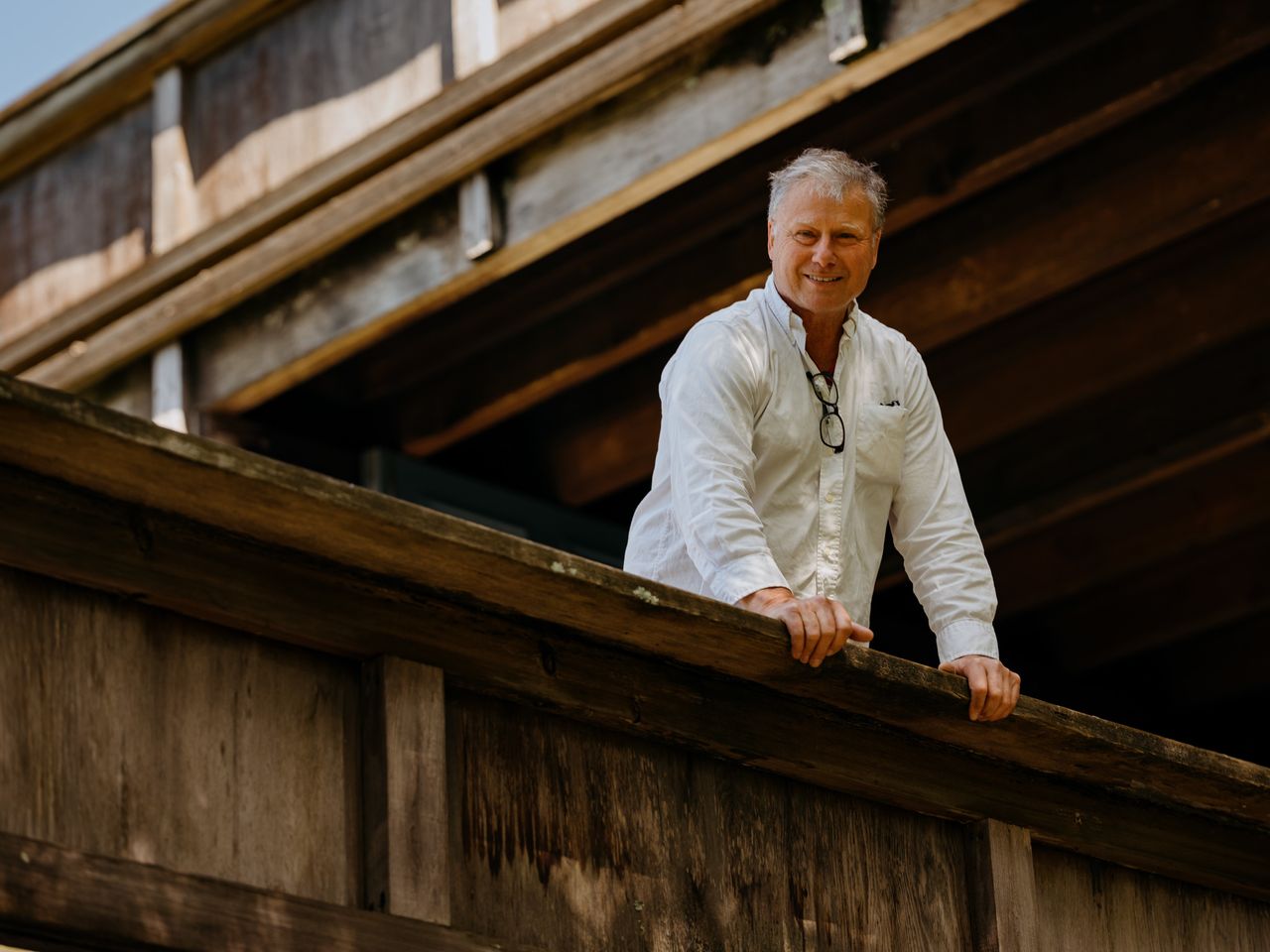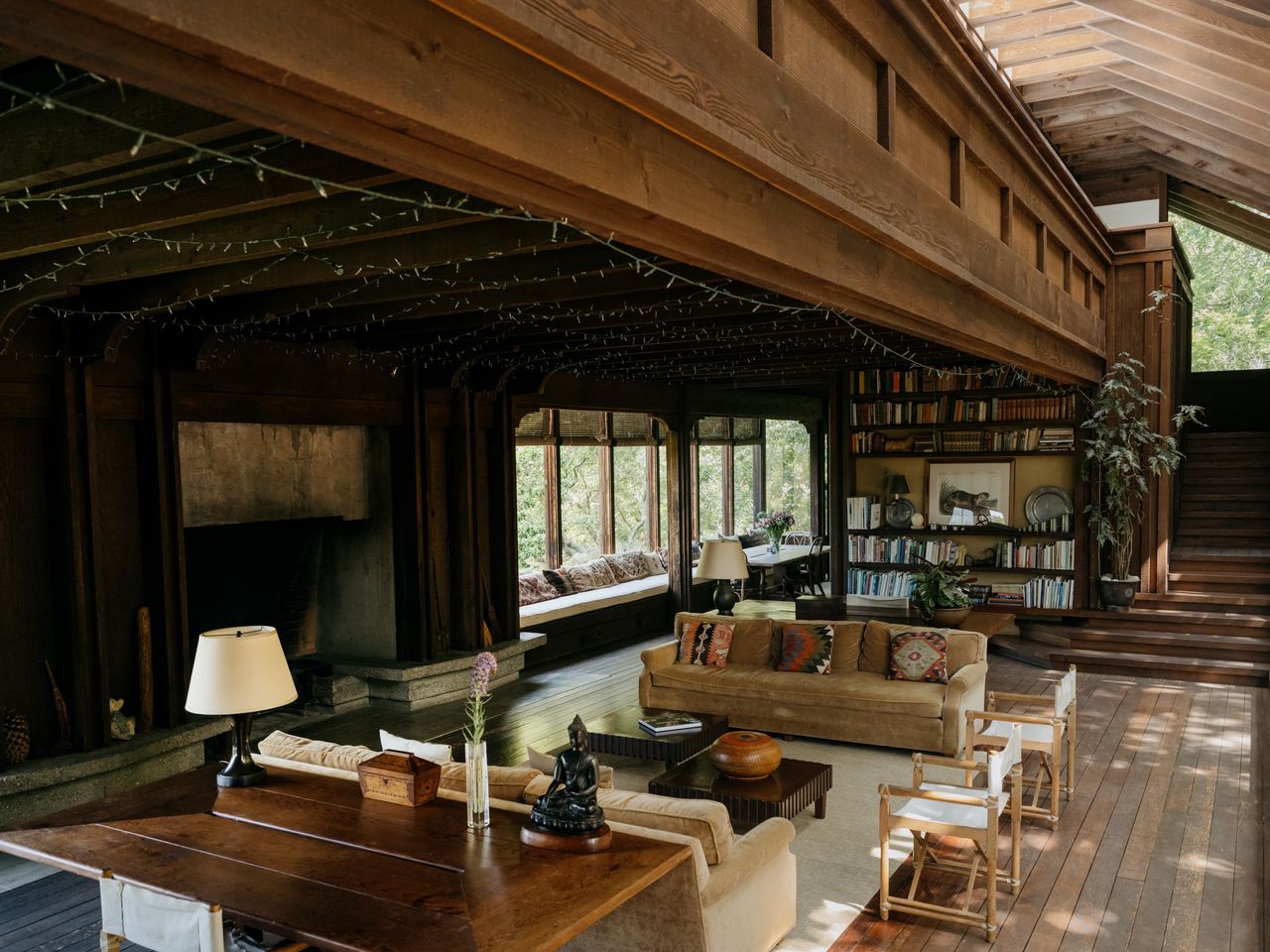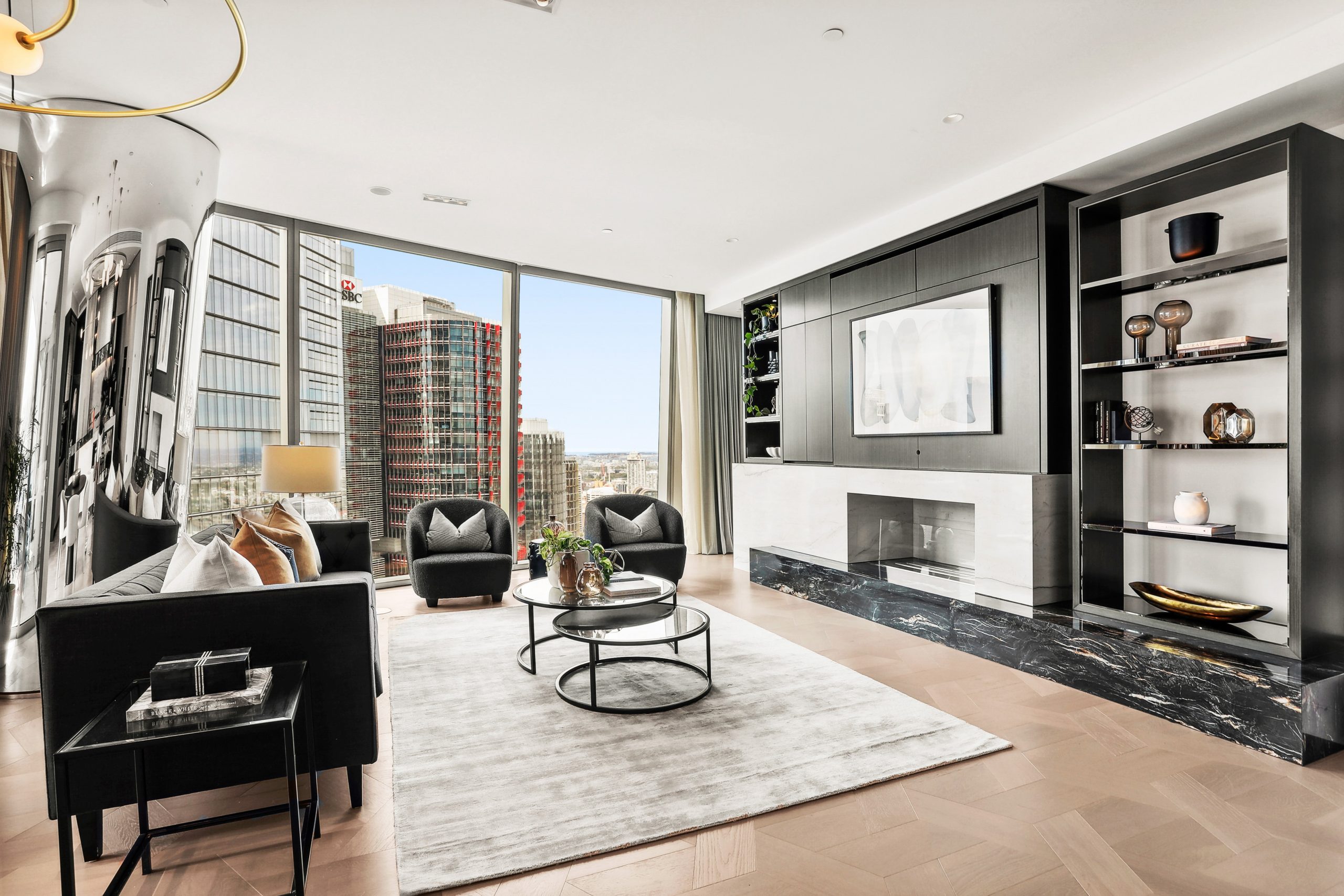In California, a John Marsh Davis-Designed Home Comes Up for Sale for the Very First Time
The Oklahoma-born architect’s Barbour House is unlike most Midcentury Modern buildings
Nestled in a thickly wooded site in Kentfield, Calif., about 12 miles north of the Golden Gate Bridge, the house commissioned by Donald and Nancy Barbour 60 years ago pairs the solidity of a barn with the intricacy of a pagoda. A giant wooden rectangle, its entry facade is made mainly of two giant glass doors. Some 16 feet high, the doors slide open so completely that inside and outside unite, with the living/dining room becoming a kind of covered porch. A vast skylight over the interior space further blurs the line between indoors and out. Bedrooms occupy a kind of mezzanine that seems to float, as does the extra-wide roof. There are supports, but a magician hid some of them in floor-to-ceiling bookcases and threaded others through wisteria-laden trellises. In that way, anything heavy either disappears or dissolves into filigree ornament.
The magician was the Oklahoma-born architect John Marsh Davis (1931-2009), who built some of the most original Bay Area houses (and a handful of Napa Valley vineyards) in the second half of the 20th century. Though labeled Midcentury Modern, his houses are nothing like the better known Midcentury Modern works of architects like Richard Neutra, which are composed of flat, white surfaces. And, though labeled organic, they are nothing like the better-known organic works of Frank Lloyd Wright, which tend to hug the ground. Mr. Davis’s houses aren’t flat, or white, or low. They soar, in a style that Hans Baldauf, the author of a new book about Mr. Davis, calls “wood expressionism.” Mr. Davis himself liked to call his approach Forgotten Modern.
Now Mr. Davis’s Forgotten Modern is being remembered. Mr. Baldauf, himself a successful Bay Area architect, discovered Mr. Davis when he was hired to design a visitor centre for the Joseph Phelps winery in Napa. He was enamoured of the vineyard’s main building, a dramatic barn-like structure split by a great trellis. To make his addition successful, he says, he wanted to know more about that building. Its designer, John Marsh Davis (a name he had never heard before), turned out to be “the visionary behind a whole series of buildings that I had long admired,” he says. Given access to Mr. Davis’s archive by his niece, Katy Davis Song, Mr. Baldauf learned enough to finish the winery project, then spent more than a decade compiling a book about the early years of Mr. Davis’s career.
“The more I dug into John’s work, the more I came to believe that it deserved to be more widely known,” he says.
One of the first buildings Mr. Baldauf visited was the Barbour house, which, he says, “bowled me over. Having designed a large sliding door on an early project, I knew the complexities involved, and here was one four times as large and almost twice as high that allowed interior and exterior to merge completely.” The residence, he adds, “is one of John’s masterpieces and established themes that he would go on to explore throughout his career.”
Mr. Baldauf couldn’t have known when his book, “Design Legacy of John Marsh Davis: Early Years,” was published in March that the house on its cover would soon come up for sale. In the wake of Donald and Nancy’s deaths, both in 2022, their three children are listing the five-bedroom, three-bath, 4,000-square-foot house on 0.75-acre for $4.995 million. (The sale includes an adjoining 0.43-acre lot.)
“The grand scale of the rooms and the views of Mount Tam will draw many potential buyers,” says listing agent Bitsa Freeman of Boulevard Marin, “Whether they can pay the price remains to be seen.” In 2023, the median sale price in Kentfield was around $4.2 million, Ms. Freeman says. “We have priced [the house] definitely on the higher end because of its esteemed architectural history.”
No one who knew John Marsh Davis as a child could have predicted his career path. Growing up, Mr. Davis later told David Sheff, a journalist who is married to the Barbours’ daughter Karen, he didn’t know what an architect was. And nothing about his birthplace, in Oklahoma’s western prairie, taught him about expressive architecture or dramatic topography.
But two things happened that had profound effects on Mr. Davis’s direction. First, when he got to the University of Oklahoma in 1951, the director of the school of architecture was Bruce Goff, a student of Frank Lloyd Wright who designed some very quirky houses, and encouraged his own students to be just as idiosyncratic. So successful was Mr. Goff as a teacher than an entire cadre of architects, who fanned out across the country in the postwar years, have together been dubbed “the American School” by scholars. Their archives (including Mr. Davis’s) are being gathered at their alma mater, now the Christopher C. Gibbs College of Architecture at the University of Oklahoma.
Second, as an officer in the U.S. Navy from 1955 to 1959, Mr. Davis was able to tour Japan extensively, according to his niece. Among the landmarks he visited was the five-story pagoda at Horyuji Temple in Nara, its vast overhangs cantilevered from a single cedar post, and its wooden joints loose enough to withstand earthquakes. After leaving the Navy, Mr. Davis spent a few years working in Oklahoma before moving to Sausalito, Calif., in 1961. There, he began building in a style that had roots in what he had seen in Japan. His first house, which he designed for himself, was an elegant wooden volume, shaped roughly like a Japanese temple, overlooking Richardson Bay.
In 1963, Donald Barbour, a young physician, and his wife, Nancy, were looking for an architect to design a house on a parcel of land they had bought in the hills above Kentfield. Ms. Barbour saw the house Mr. Davis had built for himself in Sausalito on the cover of “California Home” Magazine. She called him. Soon, says their son Steve Barbour, Mr. Davis was sketching the rough outline of the house, which included a wooden bridge over a garden as the only route to the front door.
To design that garden, Nancy called the renowned landscape architect Thomas Church, whose work included helping with the master plans for UC Berkeley and Stanford University. According to their son-in-law Mr. Sheff, “Mr. Church agreed to design the garden only because (he admitted that) he liked the sound of Nancy’s ‘husky’ voice on the phone; she had a cold at the time. He charged $100 and a bottle of vodka.” For that, Mr. Church planned a terrace garden with twisting Japanese maples in large wooden planters.
According to Nancy Barbour, Mr. Davis’s style went beyond architecture to encompass a way of looking at life. “John taught me how to see beauty in details,” she told Mr. Sheff. “As I grew up, I noticed every corner, the trim, the way the boards intersected…. John anticipated every sightline, the way the light would filter in at different times of year. Everything is lined up. Everywhere you look, there’s something dramatic and spectacular.”
As Mr. Sheff wrote in an essay in Mr. Baldauf’s book, Mr. Davis’s “relationship with the family didn’t end when the house was complete; he became a lifelong friend. He never stopped redesigning the interior of the Barbour home. He would show up with Hargrave lamps, Persian rugs and random objects from shopping sprees abroad or at flea markets.”
Steve Barbour, was only 12 when Mr. Davis began designing and building the house. At one point, as it neared completion, the banisters needed to be smoothed. Mr. Davis handed young Steve a router and said, “You can do it.” And he did it. Not perfectly, perhaps, but that’s OK. Steve, now 70, says, “The house takes your breath away. So you don’t notice any of the little things.” He adds, “It was always a joyful house. It’s emotional to see it go.”

 Copyright 2020, Dow Jones & Company, Inc. All Rights Reserved Worldwide. LEARN MORE
Copyright 2020, Dow Jones & Company, Inc. All Rights Reserved Worldwide. LEARN MORE
This stylish family home combines a classic palette and finishes with a flexible floorplan
Just 55 minutes from Sydney, make this your creative getaway located in the majestic Hawkesbury region.
Ahead of the Games, a breakdown of the city’s most desirable places to live
PARIS —Paris has long been a byword for luxurious living. The traditional components of the upscale home, from parquet floors to elaborate moldings, have their origins here. Yet settling down in just the right address in this low-rise, high-density city may be the greatest luxury of all.
Tradition reigns supreme in Paris real estate, where certain conditions seem set in stone—the western half of the city, on either side of the Seine, has long been more expensive than the east. But in the fashion world’s capital, parts of the housing market are also subject to shifting fads. In the trendy, hilly northeast, a roving cool factor can send prices in this year’s hip neighborhood rising, while last year’s might seem like a sudden bargain.
This week, with the opening of the Olympic Games and the eyes of the world turned toward Paris, The Wall Street Journal looks at the most expensive and desirable areas in the City of Light.
The Most Expensive Arrondissement: the 6th
Known for historic architecture, elegant apartment houses and bohemian street cred, the 6th Arrondissement is Paris’s answer to Manhattan’s West Village. Like its New York counterpart, the 6th’s starving-artist days are long behind it. But the charm that first wooed notable residents like Gertrude Stein and Jean-Paul Sartre is still largely intact, attracting high-minded tourists and deep-pocketed homeowners who can afford its once-edgy, now serene atmosphere.
Le Breton George V Notaires, a Paris notary with an international clientele, says the 6th consistently holds the title of most expensive arrondissement among Paris’s 20 administrative districts, and 2023 was no exception. Last year, average home prices reached $1,428 a square foot—almost 30% higher than the Paris average of $1,100 a square foot.
According to Meilleurs Agents, the Paris real estate appraisal company, the 6th is also home to three of the city’s five most expensive streets. Rue de Furstemberg, a secluded loop between Boulevard Saint-Germain and the Seine, comes in on top, with average prices of $2,454 a square foot as of March 2024.
For more than two decades, Kyle Branum, a 51-year-old attorney, and Kimberly Branum, a 60-year-old retired CEO, have been regular visitors to Paris, opting for apartment rentals and ultimately an ownership interest in an apartment in the city’s 7th Arrondissement, a sedate Left Bank district known for its discreet atmosphere and plutocratic residents.
“The 7th was the only place we stayed,” says Kimberly, “but we spent most of our time in the 6th.”
In 2022, inspired by the strength of the dollar, the Branums decided to fulfil a longstanding dream of buying in Paris. Working with Paris Property Group, they opted for a 1,465-square-foot, three-bedroom in a building dating to the 17th century on a side street in the 6th Arrondissement. They paid $2.7 million for the unit and then spent just over $1 million on the renovation, working with Franco-American visual artist Monte Laster, who also does interiors.
The couple, who live in Santa Barbara, Calif., plan to spend about three months a year in Paris, hosting children and grandchildren, and cooking after forays to local food markets. Their new kitchen, which includes a French stove from luxury appliance brand Lacanche, is Kimberly’s favourite room, she says.
Another American, investor Ashley Maddox, 49, is also considering relocating.
In 2012, the longtime Paris resident bought a dingy, overstuffed 1,765-square-foot apartment in the 6th and started from scratch. She paid $2.5 million and undertook a gut renovation and building improvements for about $800,000. A centrepiece of the home now is the one-time salon, which was turned into an open-plan kitchen and dining area where Maddox and her three children tend to hang out, American-style. Just outside her door are some of the city’s best-known bakeries and cheesemongers, and she is a short walk from the Jardin du Luxembourg, the Left Bank’s premier green space.
“A lot of the majesty of the city is accessible from here,” she says. “It’s so central, it’s bananas.” Now that two of her children are going away to school, she has listed the four-bedroom apartment with Varenne for $5 million.
The Most Expensive Neighbourhoods: Notre-Dame and Invalides
Garrow Kedigian is moving up in the world of Parisian real estate by heading south of the Seine.
During the pandemic, the Canada-born, New York-based interior designer reassessed his life, he says, and decided “I’m not going to wait any longer to have a pied-à-terre in Paris.”
He originally selected a 1,130-square-foot one-bedroom in the trendy 9th Arrondissement, an up-and-coming Right Bank district just below Montmartre. But he soon realised it was too small for his extended stays, not to mention hosting guests from out of town.
After paying about $1.6 million in 2022 and then investing about $55,000 in new decor, he put the unit up for sale in early 2024 and went house-shopping a second time. He ended up in the Invalides quarter of the 7th Arrondissement in the shadow of one Paris’s signature monuments, the golden-domed Hôtel des Invalides, which dates to the 17th century and is fronted by a grand esplanade.
His new neighbourhood vies for Paris’s most expensive with the Notre-Dame quarter in the 4th Arrondissement, centred on a few islands in the Seine behind its namesake cathedral. According to Le Breton, home prices in the Notre-Dame neighbourhood were $1,818 a square foot in 2023, followed by $1,568 a square foot in Invalides.
After breaking even on his Right Bank one-bedroom, Kedigian paid $2.4 million for his new 1,450-square-foot two-bedroom in a late 19th-century building. It has southern exposures, rounded living-room windows and “gorgeous floors,” he says. Kedigian, who bought the new flat through Junot Fine Properties/Knight Frank, plans to spend up to $435,000 on a renovation that will involve restoring the original 12-foot ceiling height in many of the rooms, as well as rescuing the ceilings’ elaborate stucco detailing. He expects to finish in 2025.
Over in the Notre-Dame neighbourhood, Belles demeures de France/Christie’s recently sold a 2,370-square-foot, four-bedroom home for close to the asking price of about $8.6 million, or about $3,630 a square foot. Listing agent Marie-Hélène Lundgreen says this places the unit near the very top of Paris luxury real estate, where prime homes typically sell between $2,530 and $4,040 a square foot.
The Most Expensive Suburb: Neuilly-sur-Seine
The Boulevard Périphérique, the 22-mile ring road that surrounds Paris and its 20 arrondissements, was once a line in the sand for Parisians, who regarded the French capital’s numerous suburbs as something to drive through on their way to and from vacation. The past few decades have seen waves of gentrification beyond the city’s borders, upgrading humble or industrial districts to the north and east into prime residential areas. And it has turned Neuilly-sur-Seine, just northwest of the city, into a luxury compound of first resort.
In 2023, Neuilly’s average home price of $1,092 a square foot made the leafy, stately community Paris’s most expensive suburb.
Longtime residents, Alain and Michèle Bigio, decided this year is the right time to list their 7,730-square-foot, four-bedroom townhouse on a gated Neuilly street.
The couple, now in their mid 70s, completed the home in 1990, two years after they purchased a small parcel of garden from the owners next door for an undisclosed amount. Having relocated from a white-marble château outside Paris, the couple echoed their previous home by using white- and cream-coloured stone in the new four-story build. The Bigios, who will relocate just back over the border in the 16th Arrondissement, have listed the property with Emile Garcin Propriétés for $14.7 million.
The couple raised two adult children here and undertook upgrades in their empty-nester years—most recently, an indoor pool in the basement and a new elevator.
The cool, pale interiors give way to dark and sardonic images in the former staff’s quarters in the basement where Alain works on his hobby—surreal and satirical paintings, whose risqué content means that his wife prefers they stay downstairs. “I’m not a painter,” he says. “But I paint.”
The Trendiest Arrondissement: the 9th
French interior designer Julie Hamon is theatre royalty. Her grandfather was playwright Jean Anouilh, a giant of 20th-century French literature, and her sister is actress Gwendoline Hamon. The 52-year-old, who divides her time between Paris and the U.K., still remembers when the city’s 9th Arrondissement, where she and her husband bought their 1,885-square-foot duplex in 2017, was a place to have fun rather than put down roots. Now, the 9th is the place to do both.
The 9th, a largely 19th-century district, is Paris at its most urban. But what it lacks in parks and other green spaces, it makes up with nightlife and a bustling street life. Among Paris’s gentrifying districts, which have been transformed since 2000 from near-slums to the brink of luxury, the 9th has emerged as the clear winner. According to Le Breton, average 2023 home prices here were $1,062 a square foot, while its nearest competitors for the cool crown, the 10th and the 11th, have yet to break $1,011 a square foot.
A co-principal in the Bobo Design Studio, Hamon—whose gut renovation includes a dramatic skylight, a home cinema and air conditioning—still seems surprised at how far her arrondissement has come. “The 9th used to be well known for all the theatres, nightclubs and strip clubs,” she says. “But it was never a place where you wanted to live—now it’s the place to be.”
With their youngest child about to go to college, she and her husband, 52-year-old entrepreneur Guillaume Clignet, decided to list their Paris home for $3.45 million and live in London full-time. Propriétés Parisiennes/Sotheby’s is handling the listing, which has just gone into contract after about six months on the market.
The 9th’s music venues were a draw for 44-year-old American musician and piano dealer, Ronen Segev, who divides his time between Miami and a 1,725-square-foot, two-bedroom in the lower reaches of the arrondissement. Aided by Paris Property Group, Segev purchased the apartment at auction during the pandemic, sight unseen, for $1.69 million. He spent $270,000 on a renovation, knocking down a wall to make a larger salon suitable for home concerts.
During the Olympics, Segev is renting out the space for about $22,850 a week to attendees of the Games. Otherwise, he prefers longer-term sublets to visiting musicians for $32,700 a month.
Most Exclusive Address: Avenue Junot
Hidden in the hilly expanses of the 18th Arrondissement lies a legendary street that, for those in the know, is the city’s most exclusive address. Avenue Junot, a bucolic tree-lined lane, is a fairy-tale version of the city, separate from the gritty bustle that surrounds it.
Homes here rarely come up for sale, and, when they do, they tend to be off-market, or sold before they can be listed. Martine Kuperfis—whose Paris-based Junot Group real-estate company is named for the street—says the most expensive units here are penthouses with views over the whole of the city.
In 2021, her agency sold a 3,230-square-foot triplex apartment, with a 1,400-square-foot terrace, for $8.5 million. At about $2,630 a square foot, that is three times the current average price in the whole of the 18th.
Among its current Junot listings is a 1930s 1,220-square-foot townhouse on the avenue’s cobblestone extension, with an asking price of $2.8 million.
This stylish family home combines a classic palette and finishes with a flexible floorplan
Just 55 minutes from Sydney, make this your creative getaway located in the majestic Hawkesbury region.






















